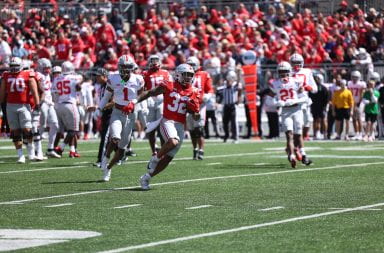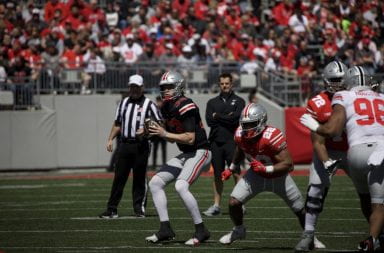
OSU junior H-back Curtis Samuel (4) runs the ball during the third quarter against Tulsa on Sept.10. The Buckeyes won 48-3. Credit: Alexa Mavrogianis | Photo Editor
A staple of Ohio State coach Urban Meyer’s offense is hard-nosed, smashmouth running by big feature backs. The success of this approach can be easily seen in Meyer’s .853 career win percentage during his 15 years as a head coach.
During his years as coach for both Bowling Green and Utah, Meyer did not have a so-called workhouse for the rushing duties. However, once he transitioned to the Southeastern Conference, Meyer gained such a player.
It began with a larger-framed quarterback while in Florida by the name of Tim Tebow. Although he threw for over 9,200 yards in his career with the Gators, the 2007 Heisman trophy winner ran for nearly 3,000 yards and 57 touchdowns while leading the team during his four year run.
After Meyer departed from the Gators in 2010 and remained out of football for two years, he arrived in Columbus. And with his arrival came the inheritance of dynamic quarterback Braxton Miller and bruising running back Carlos Hyde.
Miller threw for 2,039 yards but also added 1,271 yards on the ground. Hyde, the next leading rusher on the team, picked up 970 yards and led the team with 16 touchdowns.
Fast-forward to 2014, and the combination of then-redshirt freshman quarterback J.T. Barrett and running back Ezekiel Elliott are dominating college football. The pair rushed for a combined 2,816 yards and 29 touchdowns, numbers which could have been even higher if Barrett had not been injured in the final regular season game.
Against Oklahoma, Meyer once again proved how potent an offense powered by the run can be. In all, the Buckeyes rushed for 291 yards with just three players carrying the ball in the game — Barrett, junior H-back Curtis Samuel and redshirt freshman Mike Weber.
The Buckeyes averaged over 6 yards-per-carry, which is right on par for the team for the season.
For the past three seasons with OSU, Meyer has enjoyed the use of Elliott as a feature back. However, Oklahoma stands as a testament to the way times have changed for him.
Although Weber is the lead running back for OSU, both Samuel and Barrett have carried the ball a combined 71 times compared to Weber’s 54. Unlike other years of Meyer’s coaching career, there are two players in the backfield who can take a bulk of the carries.
After OSU faced Bowling Green to kickoff the 2016 season, he had nothing but praise for Samuel, calling him a true hybrid. Weber also received high marks, albeit with some criticism, about finishing his runs.
Meyer spoke about the philosophy of the team before Tulsa, and did not pull any punches on the team’s approach for every opponent this season.
“The identity is we’re going to line up and hammer the football and run the ball,” Meyer said. “And we expect to lead the conference or be close to the lead in rushing offense.”
Sure enough, three weeks into the season, the Buckeyes are in fact leading the Big Ten in rushing yards. OSU has 918 yards so far this year, while the Maryland is second best at 800 yards.
Currently, Weber is leading the conference individually with 351 yards, while Samuel is tied for second with Northwestern running back Justin Jackson with 260 yards.
The tandem of ball carriers in Columbus are dominating the Big Ten currently, and Meyer said he knew all along the potential of the two complimenting each other.
“I thought Curtis Samuel was a guy who waited his turn and he’s a talented guy,” Meyer said. “I think that ‘one-two punch’ is the correct way to identify (Samuel and Weber).”
During offseason camp, there were many questions about who could replace a running back like Elliott after such a productive career with the Scarlet and Gray. In contrast to years past, the Buckeyes are enjoying more than one player who can carry load in terms of carries.
For Weber, the formula to success is an easy one.
“I played my hardest every time I got the ball,” Weber said. “I tried to read my keys and do everything I could to help this team.”
The showcase of a rushing offense will be on display after the bye week in Ohio Stadium on Oct. 1 against Rutgers at noon. Currently, Rutgers ranks 13th in Big Ten in terms of rush defense, surrendering an average of 178 rushing yards-per-game.


